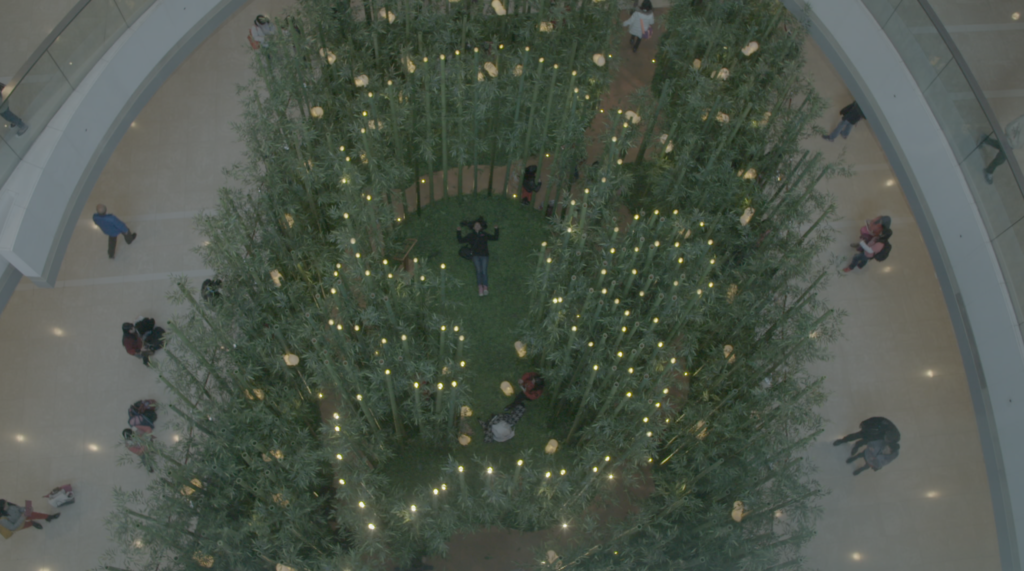Past
EXHIBITION: What does one do with such a clairvoyant image?

A two-venue exhibition co-presented by Trinity Square and Gallery 44 as a Primary Exhibition of the 2017 Scotiabank CONTACT Photography Festival.

05 May–03 June 2017
Dana Claxton, Stephanie Comilang, Kapwani Kiwanga, Dylan Miner, Martine Syms and Tania Willard
curated by Leila Timmins, cheyanne turions and Jayne Wilkinson
What does one do with such a clairvoyant image? is a group exhibition presented across two venues—Gallery 44 and Trinity Square—that explores questions of sovereignty, nationhood, and identity through strategies of speculative fiction and alternative histories of land and landscape. These artists ask how images might produce resistance to power structures, and how they can serve to write, or re-write, historical narratives. The title, taken from Kapwani Kiwanga’s work, offers a provocative claim: images have agency that extends beyond the present. Together, these works foreground the possibilities of an otherwise unsettled future against the prospect of being indentured to history.
The re-appropriation and re-use of historical and found imagery offers a range of possibilities for resistance. Tania Willard’s Only Available Light (2016) combines archival research and materials to question anthropological representations of her Secwe̓pemc community. The work departs from an educational film by archaeologist Harlan Ingersoll Smith, a member of the infamous Jesup North Pacific Expedition (1897–1902). Willard’s intervention into the film physically obstructs and distorts a clear view of the imagery. By confronting the desire of settler society to consume and exotify Indigenous cultures, Willard transforms Smith’s ethnographic video and renders it unavailable to viewers; instead, it comes only as light, as a meditation on loss and resilience transposed through time. Similarly using re-appropriated imagery, Dana Claxton’s Road Trip (2017) explores the quintessentially middle-class Canadian holiday—the road trip. Layering anonymous but familiar images of camping and leisure activities with those of beadwork patterns from the Lakota nation, Claxton’s project queries how histories are represented, and for whom. In knitting together two familiar cultural forms, Claxton emphasizes that history is an embodied and subjective story.
While the archive offers a rich terrain for speculating on the possibilities of what might have been, artists looking to the near-future recognize that the minor, everyday rituals of domestic life can make much larger paradigm shifts possible. Stephanie Comilang’s Lumapit Sa Akin, Paraiso (Come to Me Paradise) (2016) is a science-fiction documentary set among maze-like temporary structures constructed by Filipina migrant workers in Hong Kong. Narrated by a disembodied, ghostly drone, the video suggests a future where the isolation of economic migration and class can be thwarted through the emergent energy of collectivity. The mundane nature and drudgery of everyday life is likewise reflected in Martine Syms’ audio film Most Days (2014), a table-read of an original screenplay accompanied by a score composed in collaboration with Neal Reinalda, and published as a vinyl record. The project details an average day for Chanel Washington, a young black woman in 2050 Los Angeles, tracking her boredom, sense of dread, and increasing uncertainty about life. Alongside Most Days is Syms’s Mundane Afrofuturist Manifesto (2013), a text work that articulates a new theory of the Black aesthetic in the twenty-first century, coalescing around a movement of Black, diasporic artists who consider everyday moments of futurism as lived reality.
Balanced upon a fulcrum of past, present, and future, Kapwani Kiwanga’s video installation, The Secretary’s Suite (2016), uses photographic iconography to interrogate the nature of sovereign states. Throughout the video, she slowly reveals the conflicting priorities that motivate international diplomacy and gift-giving, suggesting cracks in the façade of history. The project is based on a 1961 photograph of then-Secretary-General Dag Hammarskjöld’s office at the United Nations. As Kiwanga sorts through photographs of various diplomatic gifts given throughout history, she narrates the possible intentions behind these exchanges. The stories provoke viewers to question the ways in which decisions with global implications are made, revealing the often-contradictory narratives of colonial history.
In work commissioned for this exhibition and extending across the vitrine spaces of both galleries, Dylan Miner foregrounds processes of reciprocity and redress. In omazinaakizaan: s/he takes its picture (2017), Miner uses found photographs depicting common monuments to colonial dispossession and responds to their ideological premise by scarring the images’ surfaces. His marks are not subsequent to an original image but rather are irreducible from the images themselves, refusing a distinction between temporalities and decentring the colonial gaze.
By framing these artists’ projects with a question that implies a supernatural force, What does one do with such a clairvoyant image? calls the viewer to imagine futures that are radically different from the colonial present. And during a moment that is politically charged and fraught with conflict, an underlying question remains implicit: what is to be done now, with what we sense just beyond the horizon?
EVENTS
Opening Reception
Friday, 05 May 2017, 5–7 PM
Artists in attendance
To the Landless
Walking workshop with Dylan Miner
Tuesday, 23 May 2017, 6:30–9:30 PM
Presented in partnership with WalkingLab and Gallery 44
For more information, please visit walkinglab.org
ACKNOWLEDGEMENTS AND THANKS


